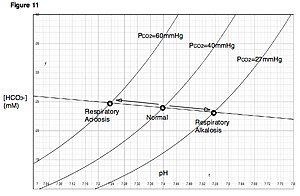Respiratory acidosis
| Respiratory acidosis | |
|---|---|
 |
|
| Davenport diagram | |
| Classification and external resources | |
| Specialty | endocrinology |
| ICD-10 | E87.2 |
| ICD-9-CM | 276.2 |
| DiseasesDB | 95 |
| MedlinePlus | 000092 |
| eMedicine | med/2008 |
| MeSH | D000142 |
Respiratory acidosis is a medical emergency in which decreased ventilation (hypoventilation) increases the concentration of carbon dioxide in the blood and decreases the blood's pH (a condition generally called acidosis).
Carbon dioxide is produced continuously as the body's cells respire, and this CO2 will accumulate rapidly if the lungs do not adequately expel it through alveolar ventilation. Alveolar hypoventilation thus leads to an increased PaCO2 (a condition called hypercapnia). The increase in PaCO2 in turn decreases the HCO3−/PaCO2 ratio and decreases pH.
Respiratory acidosis can be acute or chronic.
Acute respiratory acidosis occurs when an abrupt failure of ventilation occurs. This failure in ventilation may be caused by depression of the central respiratory center by cerebral disease or drugs, inability to ventilate adequately due to neuromuscular disease (e.g., myasthenia gravis, amyotrophic lateral sclerosis, Guillain–Barré syndrome, muscular dystrophy), or airway obstruction related to asthma or chronic obstructive pulmonary disease (COPD) exacerbation.
Chronic respiratory acidosis may be secondary to many disorders, including COPD. Hypoventilation in COPD involves multiple mechanisms, including decreased responsiveness to hypoxia and hypercapnia, increased ventilation-perfusion mismatch leading to increased dead space ventilation, and decreased diaphragm function secondary to fatigue and hyperinflation.
...
Wikipedia
